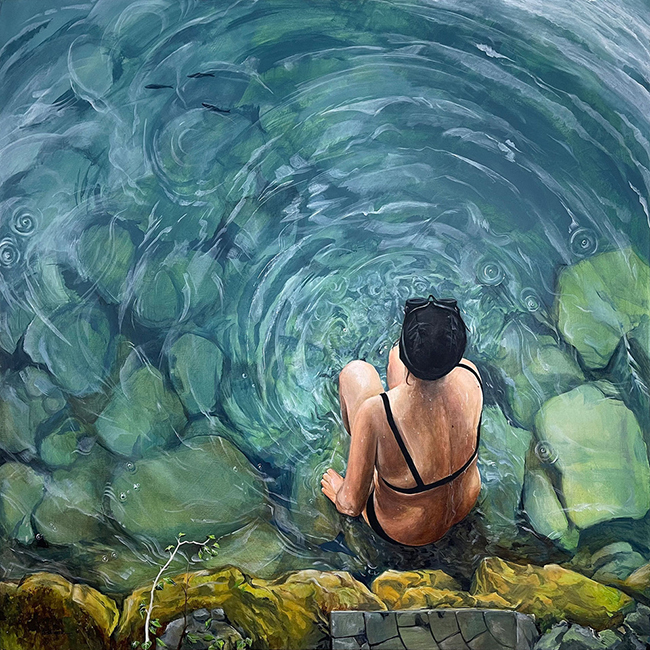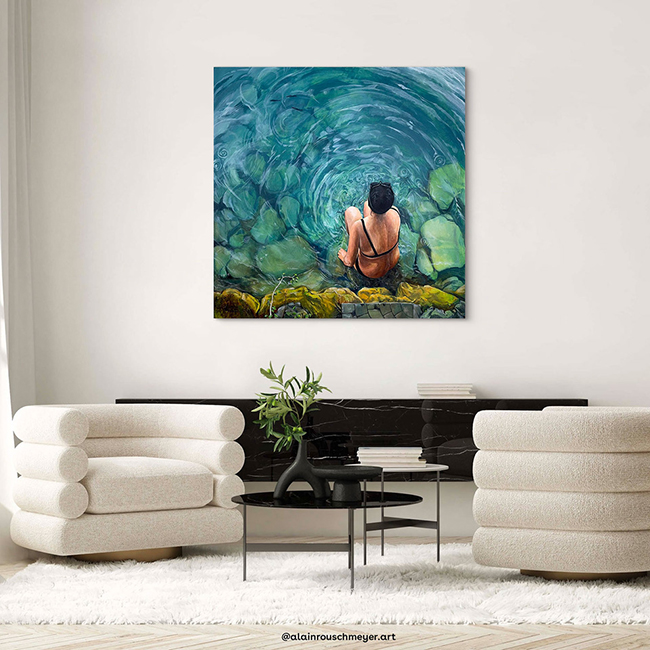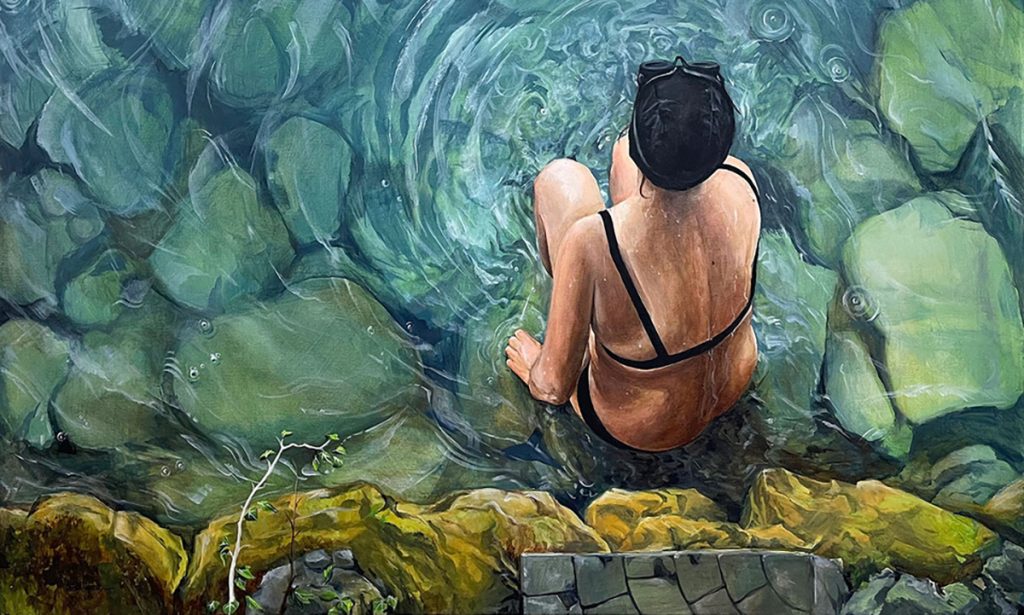Alain Rouschmeyer is an artist who bridges the gap between painting, drawing, and architecture. His work revolves around human posture within everyday spaces, exploring how physical stance interacts with its surroundings. With a background in architecture, Rouschmeyer’s art is deeply informed by an understanding of structure, framing, and composition.
Through his work, he delves into the connection between the human form and the spaces it inhabits. His careful observation of posture and movement allows viewers to see the subtle ways our bodies respond to their environments. One of his most intriguing techniques is incorporating hints of motion into static images, achieved through faint sketches of alternative postures. This approach lends a dynamic energy to his compositions, blurring the line between stillness and motion and inviting viewers to reflect on their own perceptions of space and movement.
La fille au bord du lac – A Moment of Reflection

Rouschmeyer’s 2024 painting, La fille au bord du lac (“The Girl by the Lake”), is a 120 x 120 cm acrylic on canvas that captures a fleeting yet evocative moment at the edge of a summer lake. The piece is contemporary figurative work, combining his architectural precision with a painterly sensibility for posture and environment.
The inspiration for this painting came from a ritual that Rouschmeyer has observed for years: the beginning of a swim. Camille, the subject, stands poised at the edge of a mineral-rich lake. The rocks below the surface are visible through the water, and small fish dart away from the subtle disturbance of her presence. It’s a scene that speaks to both the anticipation of movement and the serenity of stillness.
The work is deeply rooted in observation. Rouschmeyer sketched every detail of this choreography while standing on the shore, capturing not just the physical posture of the swimmer but also the interplay of light, water, and the natural surroundings. The result is a painting that feels alive, a snapshot of a moment steeped in texture and nuance.

The Posture of Anticipation
The central element of the painting is Camille’s posture. She stands at the brink, testing the water’s temperature with one tentative foot. Her body language conveys a mix of hesitation and readiness, a tension that Rouschmeyer amplifies through the composition. The viewer can almost feel the cool touch of the water and sense the imminent movement as Camille prepares to immerse herself fully.
What makes this posture particularly compelling is the way it interacts with the surrounding environment. The smooth surface of the water mirrors her form, while the jagged rocks at the bottom contrast sharply with her soft, human silhouette. This juxtaposition draws attention to the balance between vulnerability and strength, between the natural and the human.
The Environment as a Co-Author
The lake itself plays a significant role in the narrative of this painting. Rouschmeyer treats the natural elements—the rocks, water, and fish—not as a backdrop but as active participants in the scene. The mineral clarity of the lake reveals details that ground the painting in realism, while the subtle interplay of light on the water introduces a dreamlike quality.
The choice to include the fish, startled by Camille’s presence, adds another layer of life to the composition. Their movement hints at the ripple effect of her decision to enter the water, a small but meaningful interaction between human and nature.
A Dialogue Between Stillness and Motion
Rouschmeyer’s art often conveys a sense of movement within otherwise static compositions. In La fille au bord du lac,this is achieved through faint sketches embedded in the composition, hinting at alternative postures Camille might adopt. These subtle details encourage viewers to imagine the sequence of events: the lowering of her body, the splash of her first stroke, and the rhythm of her swim.
This technique transforms the painting into more than just a representation of a single moment. It becomes a conversation about time and change, inviting the viewer to engage with the piece on a deeper level. The interplay of static and dynamic elements makes the painting feel alive, almost as though it breathes with the quiet pulse of the scene it depicts.
A Familiar Ritual, Universally Understood
At its heart, La fille au bord du lac captures a universal moment—the act of stepping into water, both physically and mentally preparing for the sensation. It’s a moment of pause, reflection, and connection with the natural world. Rouschmeyer’s ability to distill this experience into a single image demonstrates his deep understanding of human behavior and its relationship with space.
This painting is more than a depiction of Camille and the lake; it’s an exploration of how we engage with our environments. The careful attention to posture, texture, and movement transforms a simple summer ritual into something profound. It’s this ability to find depth in the everyday that makes Rouschmeyer’s work resonate.


